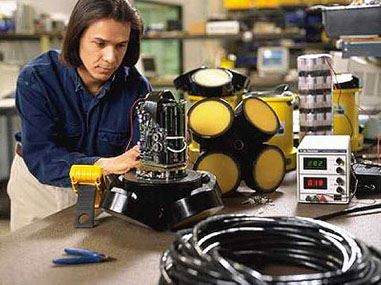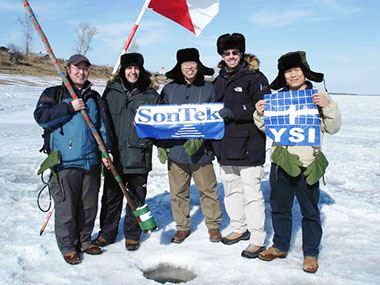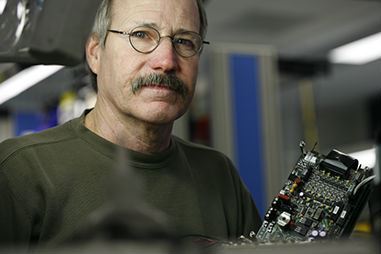A Brief History of SonTek
Since its founding in 1992, SonTek has been an innovation leader in measuring the physical movement of water—depth, velocity, waves, and flow. Building on the use of acoustic Doppler signals to measure the movement of water, founders Ramon Cabrera and Atle Lohrmann created a culture of innovation and set the stage for SonTek's global success.
Decades before, naval engineers first harnessed the ability to send out an acoustic signal, bounce it off the seafloor, and read its return signal to establish the speed and direction of ships traveling on the ocean. Following the advent of those Doppler Velocity Logs, advances in microelectronics and digital signal processing significantly improved the transmission, reception, and interpretation of acoustic signals. Those advances enabled scientists to start reading acoustic signals as they bounced off particles and bubbles suspended in the water column rather than just off the bottom of the sea. That allowed them to apply acoustic Doppler technology to profile water currents for scientific and other practical applications. The Acoustic Doppler Current Profiler (ADCP) was born.

Going with the Flow: The FlowTracker
As SonTek gained familiarity with the surface water hydrology market, the company sought to apply its instrumentation insight and innovation to develop new solutions to old problems. Driven by the pent-up demand for an electronic alternative to the classic propeller flow meter—used for over a century to measure river discharge—SonTek created the FlowTracker Handheld ADV system, which married SonTek's original ADV innovation with the ultra-flexible Argonaut platform.
Unlike the mechanical propeller meter—which required the operator to count clicks in a headset, convert the clicks to an estimate of velocity, and, ultimately, calculate discharge on paper—the FlowTracker included a handheld interface and powerful calculation software in a portable, field-ready instrument.
Handheld or mounted on a wading rod, the FlowTracker delivered robust 2D and 3D flow measurements and automatically calculated and recorded discharge. The user-friendly system also introduced SonTek's SmartQC software, a series of built-in data quality checks and automatic calibration checks that heralded SonTek's entry into enhanced user interface development.
Easy to use—new technicians could master it after a few hours of training and practice—the FlowTracker was an international hit and disrupted the worldwide use of mechanical current meters for streamflow. SonTek adapted its software package to include ISO and USGS discharge calculations and interfaces in English, Spanish, French, Italian, and German. FlowTracker sales exceeded projections and lifted the company to the next level, solidifying the SonTek brand name as a leader in innovation.
In 2007, the company moved to its present location—a more significant, newly built, better-appointed facility. Promoting a research-grade testing tank, improved workspaces for the engineers, and more commodious office space for the marketing and customer service teams that had grown to cover a global market. Staying close to its San Diego roots, SonTek had grown over the years from its experimental, "skunkworks" atmosphere into a global high-tech company in a space that encouraged further growth.
All Aboard
The RiverSurveyor S5/M9 brought a unique combination of vertical beam and 25-degree slant-angle beams that provided the capacity to profile water velocity and measure depth using bottom tracking, bottom detection, incoherent, pulse coherent, and broadband pulses and processing. SonTek's revolutionary SmartPulseHD technology provided:
- Dynamic selection and optimization.
- It allowed the S5 and M9 to automatically switch frequency and pulsing schemes for each sample based on velocity and depth to deliver seamlessly.
- It provided high-definition data over a wide range of environmental conditions.

With a RiverSurveyor S5/M9, operators could measure shallow to deep sections of a river with a single system, a task that previously required two separate instruments with different frequencies to achieve the same performance.
While programmers were developing the pinging and processing software—and making them user-friendly—other SonTek engineers developed the integrated DGPS and RTK GPS systems, batteries, telemetry packages, and hulls that supported the RiverSurveyor.
The result was revealed when the RiverSurveyor S5 and M9 were launched in 2009—rich, detailed visualizations of depth, velocity, and direction in vivid colors processed by RiverSurveyor Live software. From irrigation canals to the churning Amazon to Arctic glaciers, hydrologists could dive into mysteries of current and flow that had been buried deep beneath the surface.
As the RiverSurveyor market propelled SonTek to new heights, the company delved into the specific needs of the irrigation market. SonTek had the opportunity to collaborate with the Irrigation Training and Research Center (ITRC) at California State Polytechnic Institute and work on projects from the arid western U.S. to Spain's agricultural heartland. SonTek hosted its first user conference in Nevada and made inroads into China and other Asian markets.
Adaptations and Growth
With its SmartPulse HD technology and leadership in acoustic Doppler signaling, software, and visualization, SonTek fine-tuned and upgraded many of its instruments, integrating SmartPulse HD technology into other systems.
In laboratories and irrigation systems, from pure glacial melt to stormwater overflow, SonTek instruments have become the gold standard in a wide range of applications. And from its roots as an ocean-tech start-up to its current role as an integral part of Xylem Analytics—a global leader in analytical instrumentation—SonTek has built a reputation for innovation, quality, and a never-ending focus on the needs of its customers around the world.
